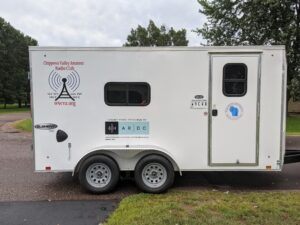Tips for making your communications trailer grant proposal stand out

The Chippewa Valley Amateur Radio Club’s communications trailer was one of the first ever funded by an ARDC Grant.
ARDC has received many grant proposals for communications trailers and vehicles over the past few years. We have funded many of these, but going forward these projects will be a lower priority for us. We will be funding some of these projects, just not as many as we have in the past. This means that for your proposal to be successful, it will have to be exceptional.
Here are some tips for making your proposal stand out:
- Emphasize how you will use your trailer or vehicle. This is perhaps the most important point. We are looking for projects that are going to be used on a regular basis and not just dragged out in an emergency. Using your trailer regularly will not only ensure that the installed systems work when there is an emergency, it’s good publicity for amateur radio.In addition, be very specific as to how you plan to use the trailer or vehicle. Don’t just say that the trailer will be used for outreach. Specifically list the outreach activities in which you plan to use the trailer. Examples of these types of activities include Field Day, county fairs, bicycle tours, marathons, and community festivals. Describe how you plan to showcase amateur radio at these events. If emergency communications is one reason that you want to build a trailer, list the emergency communications organizations that will make use of the trailer and the exercises that they hold throughout the year. You get bonus points if you will use the trailer to educate children (STEAM, Scouts, etc.), and if you have a proven track record of engaging in these kinds of activities.
- Include letters of support from served agencies or community organizations. For example, if you say that the trailer will be used to support your county’s emergency management team, include a letter from the county’s emergency manager noting how the trailer fits into their overall strategy and will help them do their jobs better.
- Show that the local community supports your efforts. We’ll look more favorably on your proposal if members of your community have donated, or are ready to donate, their time, material, or funds to help you build your trailer.
Include a complete budget and project plan
The next thing that we will be looking for is a complete and well-thought-out budget and project plan. This includes a complete list of all the expenses that you think that you’ll incur and a plan for how you’ll build out the trailer. Make sure to include:
- Cost of the vehicle. Chances are that we will not fund requests to purchase high cost vehicles, such as motorhomes or very large trailers. These vehicles are not only costly to purchase, but also to store, insure, and maintain.
- Radio equipment. Your proposal should show how the equipment you ask for will support your proposed usage. Ask yourself if you really need that $10,000 HF transceiver to provide local emergency communications or if you need that satellite station to provide communications for a bicycle tour.
- Proper heating and cooling. Trailers get hot in the summer and cool in the winter, depending on where they will be used. Without the appropriate climate control, they’re not as useful as they could be. Also include a line item for graphics. Good graphics make it clear who’s operating the trailer and what services it provides.
- Related expenses, including:
- Insurance.
- License fees.
- Secure storage costs.
- Maintenance costs.
- Contingency costs.
If you’re not asking for the entire amount, please show how you will cover the other expenses.
In addition to the budget, we will be looking at your project plan. That is to say how you will complete the build out of the trailer and installation of the equipment. We look more favorably on projects that use volunteer labor than we do pre-configured vehicles. Projects that use volunteer labor are usually more cost-effective than buying something pre-configured, and the use of volunteer labor shows that your organization has some skin in the game as well.
Finally, the proposal should demonstrate sustainability. While ARDC may fund the first year of operating expenses, you should document how the vehicle and equipment will be stored and maintained after that. Only in very rare cases, will we fund operating expenses past the first year and almost never for a trailer project.
We want you to be successful with your proposal.Even though funds for these projects may be limited, if you follow the advice given here, you’ll increase your chances for success. If you have any questions, please feel free to get in touch with us by sending an email to giving@ardc.net.